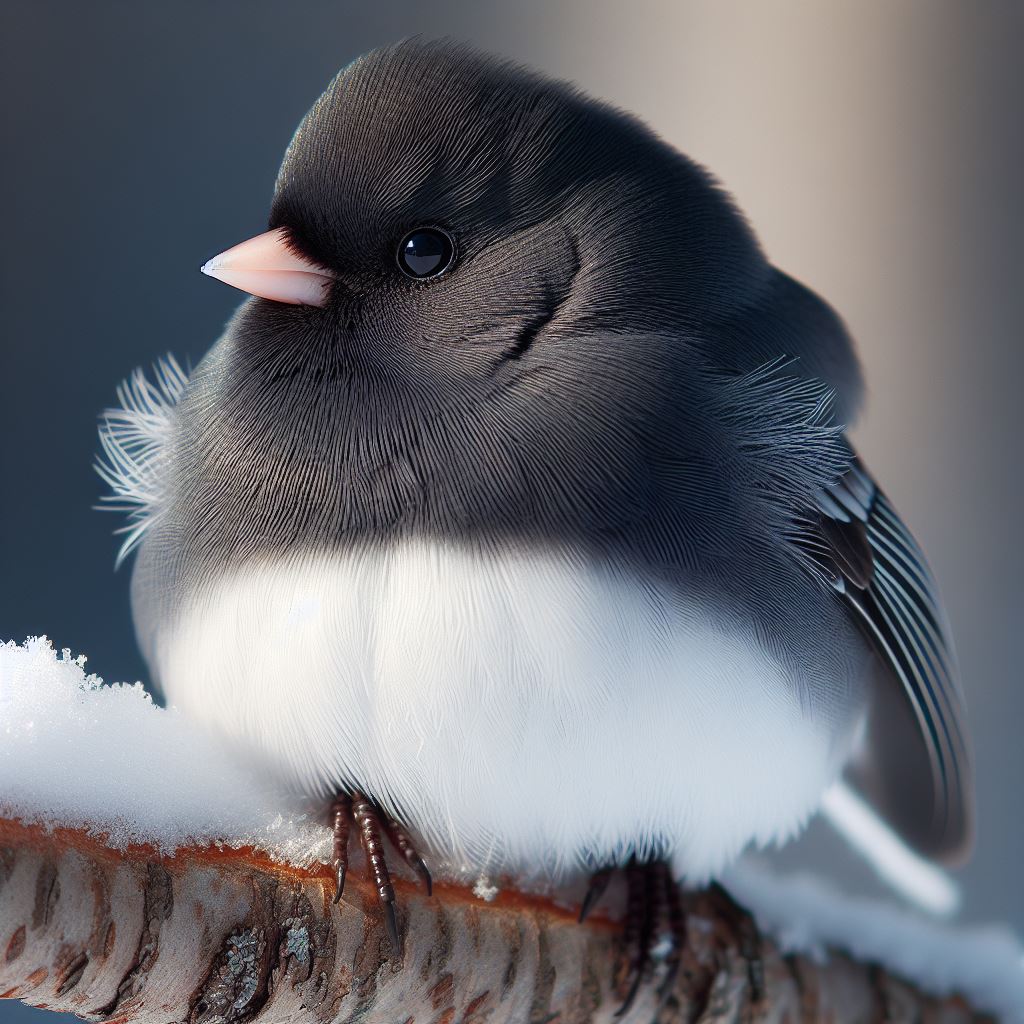Most beautiful small birds - Sykalo Eugen 2024
Dark-eyed Junco (Junco hyemalis)
Identification:
- Species name: Dark-eyed Junco
- Scientific name: Junco hyemalis
- Family: Passerellidae (New World Sparrows)
- Order: Passeriformes (Songbirds)
- Subclass: Neornithes (Modern birds)
- Class: Aves (Birds)
Description:
- Size: Small sparrow, about 14-16 cm (5.5-6.3 in) long with a wingspan of 22-24 cm (8.7-9.4 in).
- Body shape: Plump and compact, with a short neck, a round head, and a short, straight beak.
- Plumage color:
- Males: Mostly slate gray with a black hood and back, white underparts, and white outer tail feathers.
- Females: Brownish-gray upperparts with streaking, paler underparts, and white outer tail feathers.
- Pinkish bills and white outer tail feathers are common to all genders.
- Beak: Short, straight, and conical, pinkish-gray in color, suitable for cracking seeds and gleaning insects.
- Legs: Pinkish-gray.
- Tail: Short and slightly forked.
Behavior:
- Method of feeding: Primarily ground feeders, consuming a variety of seeds, insects, and berries.
- Reproduction: Builds cup-shaped nests on the ground or low in vegetation. Lays 3-5 pale blue eggs with dark markings. Both parents care for the young.
- Movement: Variable, some populations resident year-round, others migrate south for winter.
- Communication: Varied song with high-pitched chirps, whistles, and trills. Males sing to defend territory and attract mates.
Ecology:
- Habitat: Diverse, including forests, woodlands, fields, parks, and gardens with open ground and vegetation.
- Diet: Seeds, insects, berries, buds, and other plant material.
- Hunting methods: Forages on the ground, scratching leaf litter and searching for fallen seeds and insects. Also gleans food from low vegetation.
Distribution: Found across a large portion of North America, from Alaska to Mexico and east to the Atlantic coast. Some populations also found in Central America.

The Dark-eyed Junco, a common sight in North American woodlands, might seem like a modest brown bird at first glance. But beneath its unassuming plumage lies a treasure trove of fascinating facts and quirky adaptations that will leave you captivated by this feathered resident of the undergrowth:
Winter Warriors: Unlike many songbirds that migrate south for the winter, Juncos are resilient year-round residents. Their thick, insulating feathers and efficient foraging skills allow them to thrive in snow-covered landscapes. Think of them as feathered Vikings with built-in snowsuits!
Masters of Memory: Forget elephants; Juncos have a brainpower-to-body-size ratio that rivals primates. They can remember hundreds of food locations, even months later, ensuring they never go hungry during the harsh winter months. Imagine them as feathered mnemonists with built-in GPS trackers!
Snow Shoveling Specialists: Juncos' feet aren't just for perching. They have enlarged claws and specially adapted toes that act like mini snowshoes, allowing them to trek through deep snow and access hidden seeds for sustenance. Talk about feathered snow removal experts!
Social Songsters: Contrary to their solitary reputation, Juncos are surprisingly social creatures. They form loose flocks during winter, engaging in a complex communication system of chirps, whistles, and trills. It's like a feathered gossip fest in the undergrowth!
Unexpected Tool Users: Recent research suggests Juncos might be smarter than we thought. They have been observed using sticks and twigs as tools to pry open stubborn berries and even manipulate objects to reach hidden treats. Talk about feathered MacGyvers with built-in pocket toolkits!
Symbiotic Symphony: Juncos play a vital role in the ecosystem. By dispersing seeds through their droppings, they help plants spread and take root, contributing to the vibrant tapestry of the forest. These feathered gardeners even help control insect populations, maintaining a healthy balance in their habitats.
Cooperative Breeders: Though not as common as in other species, Juncos sometimes engage in cooperative breeding. Helpers, often older offspring or non-breeding individuals, assist the breeding pair in raising chicks, providing extra food and protection. It's a feathered commune with built-in childcare!
Hidden Color Variation: Did you know? Not all Juncos are created equal! While males flaunt their slate-gray backs and dark hoods, females wear a more subtle brown coat, offering better camouflage while tending to the nest. Think of it as a feathered gender-specific fashion show!